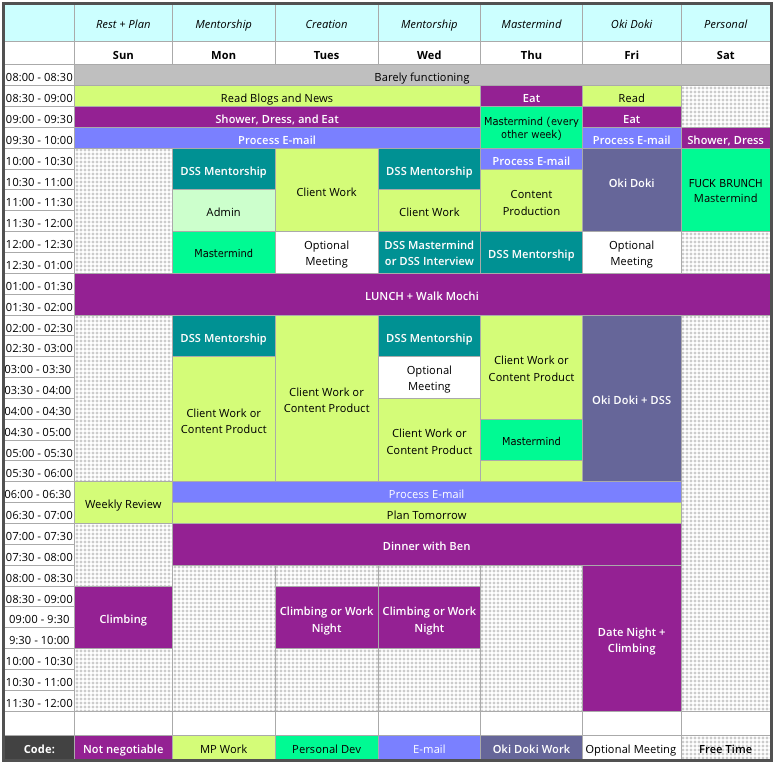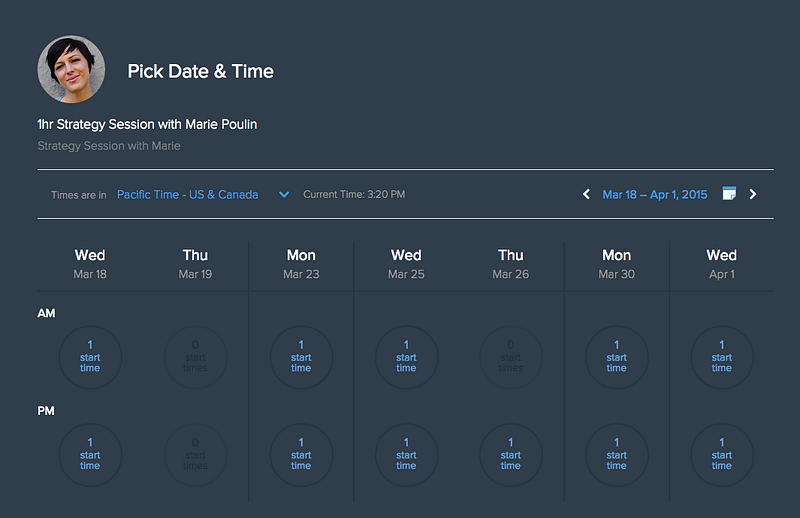The big mistake nearly every designer makes.
The big mistake nearly every designer makes
And quite honestly, it’s not a mistake that is unique to the design profession.
I’m guilty of it myself, and I see it all the time with very talented designers…
If there is one change that you could make right now that will make the world of difference in your business, it’s this:
Leave more margin.
I stumbled upon the concept of margin while reading a post by Michael Hyatt, which led me to design my ideal week.
Richard Swenson, M.D. (who wrote the book: Margin: Restoring Emotional, Physical, Financial, and Time Reserves to Overloaded Lives) describes margin like this:
“Margin is the space between our load and our limits. It is the amount allowed beyond that which is needed. It is something held in reserve for contingencies or unanticipated situations. Margin is the gap between rest and exhaustion, the space between breathing freely and suffocating.
Margin is the opposite of overload. If we are overloaded we have no margin. Most people are not quite sure when they pass from margin to overload. Threshold points are not easily measurable and are also different for different people in different circumstances. We don’t want to be under-achievers (heaven forbid!), so we fill our schedules uncritically. Options are as attractive as they are numerous, and we overbook.”
Last year I wrote about why booking too far in advance can be dangerous for your business, and this concept of margin so eloquently captures what I had recognized had been my problem: I was so booked up with clients that I wasn’t leaving any margin for error, growth, planning, or reflection. I wasn’t really growing my business in a sustainable way; I was just booking one client after the next. At the time this seemed like a good thing: doesn’t growing my business mean getting more clients?
What if instead of booking up to 100% capacity (which more often than not ends up being closer to 120%), we only booked up to an 80% capacity?
What if we left more room for growth (personal or professional) and stopped being one with “busy-ness”?
I spent nearly a year turning down every new project (and even getting rid of old ones) so that I could reduce my workload, build in more margin, and create what is now Digital Strategy School. It takes time to build margin into your schedule.
What could you accomplish with 20% more time?
Write a book. Create a program. Update your contracts and proposals (which has been on your to-do list for how long..?) Spend more time with your family. Go above and beyond for a client. Learn something new. Actually follow through on the things that have been nagging at you for a long time.
When you design your ideal week, you start to see that the time you think you have is often not in alignment with how much time you actually have.
After designing my ideal week, I had a much clearer idea of how to create a framework for my week that would empower me to feel more focused by theming days of the week, and even parts of the day. SO simple, I know. Some of you have been doing this for ages and you’re already a pro, and some of you who saw my schedule said “woah, that’s so rigid, I need more flexibility!”
But here’s the thing:
Structure enables flexibility.
Structure allows me to be in proactive mode.
Start by tracking your time.
If you’re not sure how much time you are actually spending on various tasks, use a tool like Rescue Time (their free version is excellent!) which runs in the background and tracks where your time is being spent. It can even send you weekly reports so you know exactly how much time you wasted on Facebook, or spent in your email inbox! You can assign different websites or programs/applications on a scale of very distracting to very productive, so you can see at a glance things like: which days of the week you’re most productive, which times of the day you’re most productive, and the sites on which you’re spending the most distracting time. Turns out I’m consistently “in the zone” around 3pm in the afternoon; so instead of trying to tackle highly creative work first thing in the morning (when my brain is barely functioning), I handle it in the afternoon, when I know I’m at my peak!
I manually track my time spent on general client work, meetings, and personal projects using Timely app, while leaving Rescue Time running in the background so I have a general sense of how much time I spent between apps and within different websites. With these 2 tools, I have a pretty good sense of where my time is going week to week.
Theme your days
I themed my days in a way that made sense for me:
Sunday: Rest and plan for the week
Monday: Mentorship
Tuesday: Client Work + Content Creation
Wednesday: Mentorship
Thursday: Masterminds
Friday: Oki Doki work day (new business development, design, content creation, community building, brainstorming, etc)
Saturday: Personal day: personal development, friends, errands, catch-up.
Mondays and Wednesdays are now set aside for Digital Strategy School work/mentorship, Tuesdays and Thursdays are now my major work and content creation days, while Friday is entirely set aside for Oki Doki work and planning. This is just a loose theme for the day, that still allows me some flexibility with how I spend my time each day.

I mapped out all my non-negotiable and personal time first.
This means no skipping lunches to keep working, and making physical activity a must. It’s easy to put that stuff on the back-burner when things get busy, but physical activity is so essential to my sanity, that only by mapping it out into my schedule do I actually really feel committed to it (reminders and all).

My schedule will always be a work in progress, but simply by limiting the times I’m available in my scheduler system (I use Calendly for this), I’ve managed to create more space for content creation, brainstorming, planning, designing, and just life in general.
Maybe you’ve got children, or other obligations, hobbies etc. Add them to your calendar and theme your week in a way that makes sense for your values, goals, intentions, etc.
Seriously, try the exercise for yourself — you might be surprised. If you feel overwhelmed by all the work you have on your plate, or you have time but you’re distracted and unfocused, then you definitely need this exercise!
Consider how you might be overbooking yourself, and think about what would be possible if you built more margin into your schedule (and life).
Creating more margin has been game-changing for my business.
What would be possible for yours?
Originally posted on mariepoulin.com/blog.
Marie is a digital strategist, designer, and the chief mentor at Digital Strategy School. She regularly writes about business and strategy on herblog, and collaborates with her partner Ben over at weareokidoki.com.
